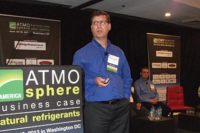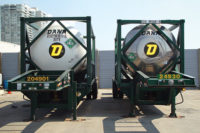Once refrigerant submitted for reclamation back to ARI-700 purity standards is found to be too mixed to go back into the market, the United States Environmental Protection Agency (EPA) and Montreal Protocol suggest that it be destroyed by plasma arc or rotary kiln methods, according to Midwest President Lewis Steinberg.
But instead of incinerating the refrigerants, Midwest has developed a process that breaks down the refrigerants to “their original chemical constituents,” as was noted byACR News, a British journal, in a January 2011 report. The conversion process is reported to be energy efficient, has negligible emissions, and there is no surviving input material.
The story noted that the output components resulting in the process are 99.999 percent purity anhydrous hydrogen fluoride, hydrogen chloride, as well as carbon dioxide and carbon monoxide. It was noted that commercial production of hydrogen fluoride, which comes from fluorospar, is said to be a critical commodity.
According to Midwest’s Steinberg, the byproducts can be resold as raw materials to manufacture newer, more environmentally friendly refrigerants and semi-conductors, and has multiple other industrial uses.
“We can take refrigerants that have served their useful life and instead of incinerating them, we can make them into something useful,” he said. According to Steinberg, ‘The process has been in development for four years and the system should be operating by the end of 2011. The technology will be licensed, meaning it can be set up in multiple locations in the U.S. and around the world. Very importantly, the process does not require large industrial facilities.”
The process is called CTC Refri-Green (or the technical name Pyrolytic Conversion of Organic Halides.) He said it has been approved for use in the United States and it is awaiting the final okay from the Technology and Economic Assessment Panel (TEAP) within the Ozone Secretariat of the United Nations Environment Programme.
INTEREST FROM ALL SIDES
NGOs (non-governmental organizations) are taking notice. Enthusiasm for the possibilities of the process is starting to be reported. According to ClimateWire, a Washington, D.C. wire service, Durwood Zaelke, president of the Institute for Governance and Sustainable Development, based in Washington D.C., said, “If they can do this and can be profitable, this seems like a very important new strategy for addressing the substances that would otherwise be emitted into the atmosphere.”Additional interest came from Stephen Andersen, co-chair of the Montreal Protocol Technology and Economic Assessment Panel. Again quoted by ClimateWire, he was quoted as saying, “A technology like this is hard to judge by a press release, but this is exactly what you would like a company to be doing for the climate. If a chemical can be disassociated and reused, then that would avoid new chemical manufacture.”
Publication date:03/07/2011





